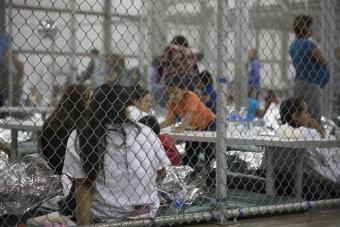President Trump’s executive order temporarily ending the separation of families at the U.S.-Mexico border and indications that the administration may, for now, be shelving its plan to prosecute all adult illegal crossers have been welcomed by many anguished over the much-contested policies. Yet lost in the din is the deeper reality: The administration’s plan to detain all asylum seekers, including families, is now on its way to completion. The “catch-and-release” that Donald Trump has long railed against is, at least in part, effectively over for now, though the price tag in human and financial costs is a long way from being tallied in full.
The administration may also be successfully setting conditions to greatly reduce the filing of asylum claims at the border, amid reports that people seeking protection are being turned away from U.S. ports of entry and new practices and policies that will limit the number of asylum seekers that pass credible-fear interviews.
And finally, even as families may no longer be separated, the fate of the several thousand children already taken from their parents remains unclear, given reports the U.S. government will not take additional steps to reunite them, leaving them in the government’s custody.
Separated Children
The President’s executive order effectively ends family separation by giving the Department of Homeland Security (DHS) custody over families both while the adults are going through any criminal prosecution and throughout their immigration proceedings. This means that if families pass a credible-fear interview and are allowed to apply for asylum in the very backlogged U.S. immigration court system, they may be detained for months or even years.
Families that have been separated to date, however, face numerous hurdles being reunited because they were placed on two completely separate procedural tracks.
We know that at least 2,342 children were forcibly separated from their parents between May 5 and June 9. Undoubtedly hundreds more were taken from their parents before and since then. These children have been reclassified as unaccompanied child migrants and as such, have been placed into a special system, which includes being transferred to the custody of the Office of Refugee Resettlement, later placement with a sponsor or in one of about 100 licensed facilities, and entry into formal, long-term immigration proceedings—which stretch on for years. The parents, meanwhile, are put into expedited removal proceedings, in which most are detained and removed from the country within a few days. A minority of the parents may pass a credible-fear screening and will be placed in long-term immigration proceedings. But the administration is intending to detain them during the pendency of these proceedings.
As of yet, the administration has articulated no plan to reunite these parents and children. Doing so would require a massive logistical system, which should start by contacting each parent to determine whether the adult wishes for the child to stay in the United States and apply for asylum or return home. Information-sharing between U.S. Immigration and Customs Enforcement (ICE) and ORR appears to face significant gaps, with reports of some mothers deported back to Central America as their children were left in the United States, and of detained parents not knowing where their child is and vice versa. Some experts, including a former ICE director, have suggested it is possible or even likely that some of these children may never be reunited with their family.
Backlogged Ports of Entry
When implementing the zero-tolerance policy announced by Attorney General Jeff Sessions in early April, which mandated prosecution of all illegal entrants, Homeland Security Secretary Kirstjen Nielsen and other officials encouraged asylum seekers to apply at U.S. ports of entry. However, asylum seekers are being regularly denied admission at ports of entry, where U.S. Customs and Border Protection (CBP) officials have said resources are insufficient to process all asylum seekers.
As asylum seekers are turned away several days in a row, forced to wait in Mexico, the likelihood grows that they will instead attempt to enter the country illegally and be subjected to the same zero-tolerance policy that the administration has claimed it wants them to avoid. By failing to increase resources at ports of entry to accommodate its own policy changes, the administration is obstructing the internationally recognized rights of foreign nationals to apply for asylum.
Narrowing the Grounds for Asylum and Possible Rollback of Credible Fear
When foreign nationals who are not authorized to enter the United States are apprehended at the border, they are placed into expedited removal proceedings in which they are detained and deported within a few days. Any foreign national who expresses fear of returning to his or her home country is entitled to a credible-fear interview, during which an asylum officer assesses whether the migrant has a credible claim to apply for asylum. Those with credible claims are permitted to enter the United States to apply for asylum before an immigration judge.
The Trump administration is taking steps to limit the number of foreign nationals who pass the credible-fear interview, and possibly how many are given the opportunity to express credible fear in the first place. A little over a week ago, Sessions announced a legal decision making it far more difficult for individuals to qualify for asylum based on fear of domestic or gang violence—grounds cited by many Central Americans. In his opinion, he specifically said few of these claims should rise to the standard necessary to pass the credible-fear interview. Since many of the asylum seekers arriving at the U.S. border today are escaping gang or domestic violence, this is likely to significantly limit how many pass the credible-fear interview.
There have also been new reports that foreign nationals are not being told of their right to express fear or speak to an asylum officer during their expedited removal proceedings. If true, this would violate U.S. regulations that specifically require DHS personnel to read foreign nationals a notice that includes such information.
Moving Forward
The signing of the executive order and possible temporary lifting of the zero-tolerance policy—there were still conflicting reports about the latter late Thursday—are far from defusing the complex humanitarian, policy, and governance crisis that the administration engineered.
And there are endless questions about the way forward. To comply with the President’s order to detain all families, DHS will have to massively expand its family detention capacity, which currently is about 2,700 beds. Even if the space is secured, vast new resources will be needed to house and care for this population. And while it is a small relief that these families will be indefinitely detained together, the President could reinstate family separation with another stroke of a pen.
Attention now turns to the courts or Congress, to see how they weigh in. Recognizing that his executive order conflicts with federal rulings under the 1997 Flores settlement, the President ordered Sessions to file a petition requesting a federal court in California to lift its ruling constraining the government’s ability to keep children in immigration detention. All parties recognize that though the court is unlikely to do so, the move is more likely designed to provide Congress time to change the law. However, House Republican leaders on Thursday night delayed a vote slated for this week on immigration legislation that would, among many other provisions, address family separation. (For an analysis of how that legislation would largely dismantle the U.S. humanitarian system at the southern border, see this MPI commentary.)
As some pundits describe this week as a political setback for the President, an administration that thrives on chaos may view the crisis as one that has resulted in a significant victory, even at the expense of current PR hits. The steps the executive branch has taken over the past few months are in effect creating a virtual wall that limits the ability of foreign nationals to enter the United States and apply for asylum once they are here. These steps, which raise questions regarding the obligations of the United States under U.S. and international laws and norms, are sure to face sustained legal challenges.
There are humane and effective alternatives to long-term detention. For example, 99 percent of families in the Family Case Management Program (FCMP) that the Trump administration shuttered last year showed up for their deportation hearings. These programs are also cost-effective: FCMP cost $36 per family per day, compared to the $298 it costs to detain one family each day at the ICE facility in Dilley, Texas. Over the course of a year, such programs could save the government hundreds of millions, if not billions, of dollars, considering the administration’s potential detention of tens of thousands of individuals.
Beyond dollars and cents, perhaps the most pressing unresolved issue at this moment is the human dimension: What is going to happen to the thousands of children who have already been separated from their parents?







